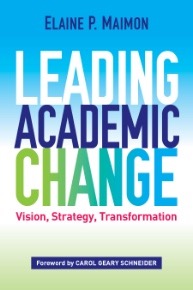
Leading Academic Change: Vision, Strategy, Transformation
Date Reviewed: September 18, 2018
College students were far more uniform in age, race, and socio-economic background a few decades ago than they are now, yet colleges and universities have often failed to design programs of study that work for these students. Leading Academic Change outlines the steps to take toward change on behalf of the new majority students, the non-white, low-income, working, second language, or adult learners who often find themselves in very unfamiliar territory in college classrooms. These “first generation exclamation point” students (xiv) most often encounter ineffective and even counterproductive general education and distribution sequences, and many are transfer students from community colleges, whose curricula are at odds with those at 4-year institutions. This book proposes workable solutions to multiple missed connections.
This book is less for classroom teachers than for administrators interested in meaningful structural change. Maimon relies primarily on data from years of innovation in Writing Across the Curriculum programs as well as on her own considerable administrative experiences. The central case study is Governors State University, which has successfully implemented high impact practices and a more integrated, student-centered curriculum with low administrative bloat. Drawing on the work of Judy B. Rosener, Maimon draws a clear distinction between traditional “transactional” leaders and “transformative” leaders (5). Transformative leadership brings everyone to the table and works collaboratively to achieve shared goals. Maimon aims at collaborative transformation with student success at the core.
Maimon provides many concrete, multi-faceted suggestions here. In brief, the institutional transformations she supports rely on a close interaction of students and faculty, who are in this venture together. She insists on several key components to transforming institutions: a commitment to keeping funding closer to students than to administrative offices; close cooperation between student affairs personnel and classroom faculty; a willingness to take advantage of high tech while maintaining “high touch” with students; an ability to see students as people in development, who need feedback through assessing for strength, not deficit; and a willingness to allow students’ lives to enter the classroom and to inform – rather than be at odds with – the curriculum.
Despite its emphasis on institutional change, this book does get down to the classroom level in several ways, particularly in emphasizing the importance of respecting students for who they are and what they know. That respect and recognition of prior knowledge can help teachers and academic leaders to scaffold a curriculum of knowledge and skills that makes sense for all concerned. Maimon also calls teachers to humility rather than judgment. She decries the endemic “Maimon Hierarchical Fallacy” which holds that some teachers in some disciplines are “smarter” than others based on how abstract their work appears to be or the level of the students they teach (57). This damages students as well as teachers and can starve introductory courses and students of the best teachers. This book is, above all, a call to give all students our very best, both in our classrooms and at our institutions. It is also a well-timed reminder that change is inevitable and that equity can be a means to achieving educational quality.